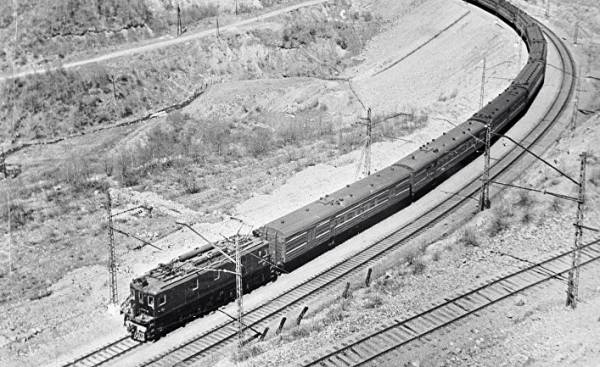
On the platform of the end station of the TRANS-Siberian railway in Vladivostok there is an obelisk, on which is carved “9288”. These figures mean that the distance from here to Moscow is 9 thousand 288 kilometers. More than from the equator to the North pole. A trip on the TRANS-Siberian railway will take 156 hours (6 nights and 7 days, 56 stations) on the way you will cross 16 rivers and 7 time zones.
“If you want to feel the size of the Earth, drive on the TRANS-Siberian”, and these words are not an exaggeration.
One of the most important for humanity construction began on March 9, 1891, with a decree of Russian Emperor Alexander III. To personally attend the groundbreaking ceremony for the heir to the throne Nicholas II went to East journey. In the framework of the heir visited Japan, where he was assassinated. Avoiding serious wounds and returning home, Nicholas II, with a bandaged head, taking the first wheelbarrow of earth on the canvas of the future road and laid the first stone in the building of Vladivostok rail station on may 31.
In October 1905, the year on the TRANS-Siberian has started a continuous movement of trains from Moscow to Vladivostok. But in the same year, Russia was defeated in Russo-Japanese war and the Portsmouth peace Treaty rails from the southern part of the railway was transferred to Japan. In April 1908, construction on the Amur land was resumed. Finally, 25 years after the beginning, the construction was completed on the 18th October 1916. 4 months after the opening of the railway Nicholas II, who led the entire process from beginning to end, was deposed and executed the February revolution.
The end point of the railroad — Vladivostok, whose name means “possession of the East.” Transsib — a product of Russian policy in the East, and the means of its promotion. Therefore, from the very beginning of the construction of this railway was closely connected with the people of the Korean Peninsula.
So, the special envoy in the Hague, Lee Joon-Eun (Lee Jung Eun) on may 21, 1907, boarded the train in Vladivostok and did the full path to St. Petersburg, where he arrived the 4th of June. In 1911, the year the leader of the rebel army Lee Beom-young was exiled to Irkutsk and disbanded part fought for the independence of the army in 1921, the year was taken prisoner and sent to serve his sentence it is for the TRANS-Siberian railway. In 1925, the year of Cho Bong-Am went on the TRANS-Siberian to Moscow to announce the creation of the Communist party of Korea at the headquarters of the International Communist party. In 1927, the year the first Korean-Westerner, artist and fighter for women’s rights, To Hae the Juice is left with her husband for the TRANS-Siberian railway to travel around the world.
The Korean people became widely known after the release of the TRANS-Siberian railway in 1933 novel by Korean writer Lee Kwang soo “Oil well”. The main character goes to conquer the world, and his way lies through Siberia. The main character goes to find him and describes his train ride and lake Baikal. Sam Lee Kwang soo was published in America and was appointed chief editor in San Francisco. Through Siberia and Europe, he goes to the Atlantic ocean, but during his visit the First world war, and writer have to stay in Chita for six months.
Sleep Ki John and our Son Jon, who won gold and bronze medals at the Olympic games in Berlin in 1936, also traveled the TRANS-Siberian railway. A long journey did a Japanese athlete sung soo and tan, who went from Tokyo to Seoul on the ship, then through Sinuiju (city in Korea — approx. ed.), Dandong, Shenyang and Harbin to Chita and Berlin.
In 1937, the year, during the Stalinist regime, has been involuntary resettlement of about 2 hundred thousand Koreans from Primorye in Central Asia. In the process of moving the cars Luggage compartment of a train killed twenty thousand Koreans. The official reason for the move was to “prevent the infiltration of Japanese spies”, but scientists speculate that in fact the reason was a shortage of manpower in Central Asia, the desire to prevent the consolidation of the Korean Diaspora and to avoid conflict with Japan.
Transsiberian is associated with Kenjisan, the oldest railway line Korea, through Manchuria railway. Since the beginning of the 21st century was put forward a number of projects connection the TRANS-Siberian railway and Sinuiju by Transitional or railway’s TRANS-Korean Railways. But on Chinese and Korean sections of the rails needs to be replaced with standard (1435 mm) to a wide (1520 mm), with axles and wheels must change at the points of connection.
In 2014, the research Institute of the Railways of Korea (KRII) has developed a technology with variable speed that can run without change of wheels, even if the track width is different. If the railway from Busan to Europe will be built, it is expected to bring huge income in various fields, as well as save logistics costs.
23 July at 19:10 from Vladivostok departed the Train of the memory of forced relocation of Koreans in the Soviet Union. 86 people went on a trip to Almaty (6500 km) in the footsteps of history in search of establishing peace on the Korean Peninsula and reunification of the Korean nation. I sincerely hope that the TRANS-Siberian railway, who became 80 years ago “road of death”, will this time play a positive role in the reconciliation of North and South in the prosperity of northeast Asia.







